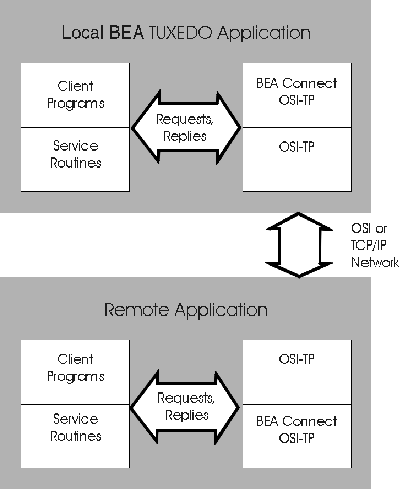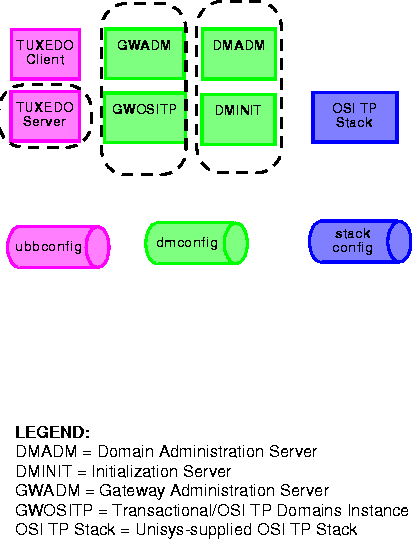This chapter will cover the following topics:
BEA Connect OSI TP is a gateway connectivity feature that, together with Unisys OSI-TP software and Unisys Upper Layer Services (ULS) software, makes it possible for OLTP application programs on BEA TUXEDO systems to perform global transactions and various non-transactional tasks with application programs in the following environments:
Connect OSI TP Overview
Unisys TransIT CONNECT Upper Layer Services is a software product that implements various OSI application, presentation, and session layer services. ULS is used in conjunction with TCP/IP subnetworks.
The X/Open XATMI standard is an interface that application programs use to communicate with other application programs both inside and outside of global transactions. It supports conversational and request/reply communication styles and is fully implemented by BEA Connect OSI TP.
Data mapping and transformation between the BEA TUXEDO and mainframe environments is easily automated in BEA TUXEDO-based applications with the BEA TUXEDO typed buffer mechanism. This mechanism allows system administrators to predefine how data should be conveyed to the remote application. Application programmers do not need to be aware of this translation; they can simply continue using the buffer types defined for the local application.
BEA Connect OSI TP is designed to provide transparent access to remote services that reside outside a BEA TUXEDO application. In addition, BEA Connect OSI TP provides remote application programs access to local services.
BEA Connect OSI TP and other BEA Connect products act as gateways between BEA TUXEDO systems and other online transaction processing environments. To establish connections with remote systems, an administrator will:
Figure 1-1 BEA Connect OSI TP Sample Environment

Establishing Remote Connections
BEA Connect OSI TP supports the following features:
Connect OSI TP Features
A BEA TUXEDO application consists of client and server programs that operate across a network of BEA TUXEDO systems. Any client program can request services that are offered by any server program running on any computer in the application. Also, the location of server programs is kept transparent by way of a directory that maps services to servers.
As Figure 1-2 shows, BEA Connect OSI TP extends this transparent access by sending requests to and receiving requests from remote systems through OSI TP and supporting network software.
As Figure 1-2 suggests, inside a single application, BEA Connect OSI TP operates between the BEA TUXEDO software and OSI TP.
BEA Connect OSI TP and BEA TUXEDO Architecture
Figure 1-2 Routing Service Calls through BEA Connect OSI TP

BEA Connect OSI TP is implemented as an ordinary BEA TUXEDO server group. It accepts standard BEA TUXEDO service requests and returns standard replies.
The BEA Connect OSI TP server group consists of the following components:
One BEA Connect OSI TP server group acts as a gateway to multiple communications targets. Each communications target is a unique OSI TP endpoint.
Some remote targets, such as remote BEA TUXEDO applications, also support BEA Connect OSI TP. In this situation, BEA Connect OSI TP servers associated with the local gateway communicate with BEA Connect OSI TP servers associated with remote gateways through OSI TP.
Other gateways, such as remote Unisys A Series Open/OLTP systems and OS2200 Open/OLTP systems, provide analogous functionality to which local BEA Connect OSI TP servers can interact.
Although remote systems are identified in the BEA Connect OSI TP configuration, they remain unknown to BEA TUXEDO software. For example, remote systems that are accessible through BEA Connect OSI TP are not identified in the *MACHINES section of the UBBCONFIG file. Also, UBBCONFIG files are not propagated to remote machines that are accessible through BEA Connect OSI TP.
Remote services identified in the BEA Connect OSI TP configuration are advertised to the BEA TUXEDO software directly by BEA Connect OSI TP gateway servers. The remote services are not identified in the *SERVICES section of the UBBCONFIG file.
BEA Connect OSI TP maintains its own control information in shared memory, in much the same way that BEA TUXEDO software itself maintains the Bulletin Board. Although BEA Connect OSI TP accesses the BEA TUXEDO Bulletin Board, BEA TUXEDO does not access BEA Connect OSI TP control information.
Note:
To a remote system that supports the X/Open XATMI standard (more specifically, an XATMI application service element), the BEA Connect OSI TP server group appears as a communications resource manager (CRM).
The Connect OSI TP is composed of several elements that can be configured to provide OSI TP solutions. For the most part, the OSI TP domain is much like the other domain gateways. It uses the DMADM and GWADM servers provided with BEA TUXEDO for administration. The following diagram describes each component of the Connect OSI TP product:
OSI TP Domains Components
Figure 1-3 Domain Components

Gateway Servers
The OSI TP Domain Gateway (GWOSITP) uses the administrative servers provided with BEA TUXEDO for domain and gateway configuration and administration. Specifics of configuring the various sections of a domain are covered in the BEA TUXEDO document BEA TUXEDO /Domain Guide, as well as the references page for dmconfig in Appendix B, "Reference Pages".